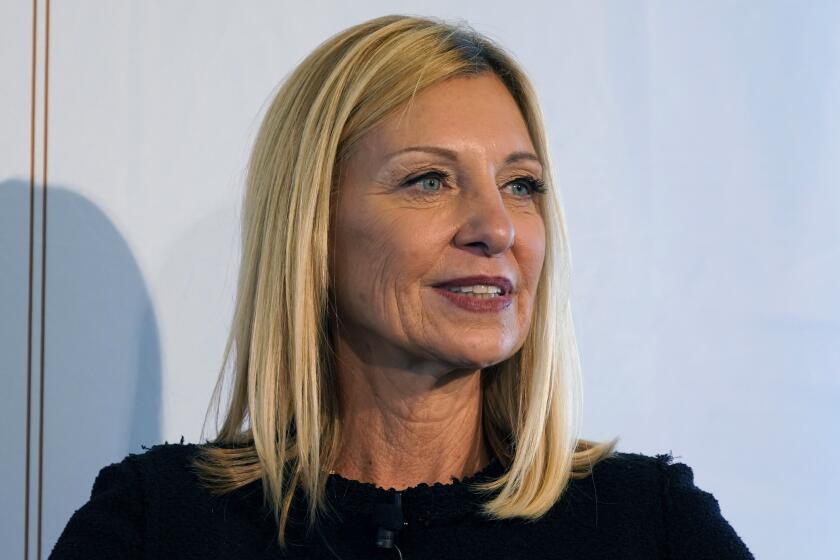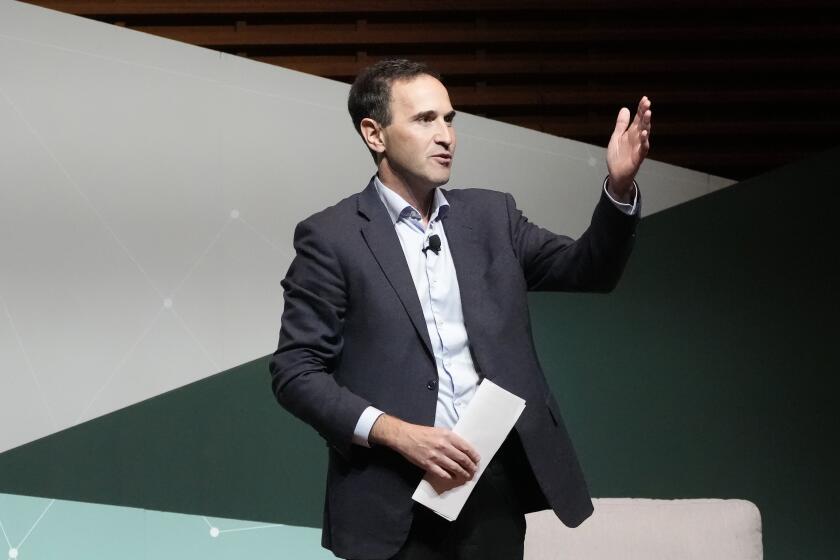Yule Overspending : And a Bill Collector in a Pear Tree
If volume of gift giving is a measure of Christmas spirit, Wendy Johnson certainly had lots of spirit.
The Chatsworth resident thrived on giving gifts. Two years ago, she spent about $5,000 on Christmas presents for about 40 colleagues, family members, friends and even casual acquaintances. She gave a $150 microwave oven to a colleague she hardly knew, just because the woman needed one.
“I just loved buying things for people,” Johnson recalls.
There was only one problem: She couldn’t really afford so much generosity on her moderate income. Her Christmas spending sprees, along with other buying frenzies the rest of the year, were financed through her 35 credit cards, and the tab on them at one point reached $42,000. Increasingly hard pressed to pay, she considered filing for personal bankruptcy but instead went to a credit counseling service that worked out a repayment schedule for her.
Ballooning Debt
Johnson’s case is not an isolated one. Because Christmas is the most intensive period of retail sales activity, Yuletide overspending is a significant contributor to the ballooning consumer debt burden. Personal bankruptcy filings are running at record highs, and many consumers cannot get credit to buy homes or cars, experts say. Such problems could worsen if the economy lurches into a recession, an event some economists fear could occur next year.
While Christmas shopping is not the largest of the many sources of growing consumer debt--borrowing for homes and cars is far larger--it is often the last straw, advisers say.
“For many shoppers, misuse of their credit cards this season could push them over the debt cliff, obligating them for payments they will simply be unable to handle,” says Elgie Holstein, executive director of Bankcard Holders of America, a Herndon, Va., consumer group.
Debt Collection Climbs
“This whole season is the time you see lots of people getting into financial trouble,” says Les Kirschbaum, president of Mid-Continent Agencies Inc. in Glenview, Ill., one of the nation’s largest debt collection agencies. The company typically sees a 30% hike in its activity after Christmas.
Overall, American families are expected to spend an average of $325 on Christmas gifts this year, up 7% from last year, according to a survey by the Conference Board, a New York business research organization. For most households, that level of spending is very manageable.
But tens of thousands of families go overboard, according to Don Badders, president of the National Foundation of Consumer Credit Counselors, which oversees 410 nonprofit credit counseling centers nationwide. He says 40% of the more than 200,000 families or individuals seeking help at the centers do so in January and February--just when they start receiving Christmas-related bills.
Financial advisers blame the growth in Christmas overspending on several factors, including the strong economy.
“People feel that their income will be there to pay the debts,” says Robert B. McKinley, editor-publisher of RAM Research, a Frederick, Md., firm that tracks credit card rates. “With unemployment down, it looks rosy and therefore people tend to spend freely.”
Consumers with debt troubles also blame the growing materialism of the holiday season.
Material World
“Today’s society is so caught up in material things . . . you get obligated to overindulge and overspend,” says Susan Randolph, 30, a Los Angeles business manager who, before seeking counseling, once had nearly 20 credit cards with close to $10,000 in debt.
Experts also blame the easy accessibility of credit cards. The 107 million consumers with credit cards today hold an average of about 7.8 of them per person--including about 2.7 bank-issued cards and the remainder being retailer, gasoline or phone cards, according to David Robertson, vice president for marketing at the Nilson Report, a Santa Monica newsletter that tracks the credit card industry. That is up from about 5.8 cards per person in 1980, Robertson says.
Consumers are more likely to let credit card payments slip than home or car payments, because defaulting on card debts is not likely to result in belongings being repossessed. Failing to make mortgage or car payments, on the other hand, can eventually mean the loss of a house or car.
Enticements Blamed
Some consumer advisers also blame programs by retailers and credit card marketers aimed at enticing people to spend more. Holstein of Bankcard Holders of America cites, for example, deferred payment plans in which retailers allow customers not to make payments for several months after Christmas.
“This is often misunderstood by consumers who don’t understand they will be accruing hefty interest charges in the meantime,” Holstein says.
He also criticizes retailers for what he calls “phony” pre-Christmas sales, in which they raise prices and then discount them to create the illusion of a sale.
Others point out the proliferation of mail order houses, televised home shopping services and other ways to spend money. “It’s just exploding,” collection agency executive Kirschbaum says.
Consumers who get into trouble often lack discipline and fail to set reasonable budgets, or they succumb to impulse buying, financial experts say. “People go out with credit cards and just start buying, and then when the bills come in they realize they really overspent and are in trouble,” says Badders of the consumer credit foundation.
All Those Extras
“People go along during the year with a budget, but all of a sudden Christmas comes along and it’s a whole different ballgame. People don’t plan. They have extra entertainment, parties, going out more, and the next thing they know, they are $2,000 to $3,000 into debt that they hadn’t planned on,” Kirschbaum says.
Overall, outstanding consumer debt rose to $646 billion in July, up 13% from $571 billion at the end of 1986, according to the Federal Reserve. But credit card debt had grown even faster, hitting $175 billion, 29% more than the $136 billion recorded just a year and a half earlier.
Perhaps the most telling evidence of soaring debt is the record number of personal bankruptcy filings. Despite the continued economic expansion and low unemployment rate, one in every 178 households nationwide--one in every 115 in California--will file for personal bankruptcy this year, according to the Nilson Report. The more than 500,000 personal bankruptcy filings this year will cost creditors an estimated $12 billion, the newsletter says.
Credit card issuers and marketers have recognized the problem of overspending and are doing something about it. Both Visa and MasterCard, for example, provide enhanced electronic systems enabling merchants to check consumers’ credit worthiness and reduce fraud.
Fees Are Raised
Issuers also are raising credit card fees and keeping interest rates high to recoup losses.
“Bankruptcies are the single biggest reason why bank card rates have not come down, and they will be the largest contributing factor to higher interest, annual fees and elimination of grace periods in the future,” the Nilson Report says. Nearly 75% of the average annual bank card fee of $18.50 goes to cover losses from bankruptcies, the newsletter says.
Nonetheless, card firms are encouraging consumers to use their plastic more this holiday season.
MasterCard is in the second year of a “Choose to Make a Difference” program under which it donates a fraction of each card purchase between Oct. 1 and Dec. 31 to six charities.
Visa is rolling out three major programs and a national advertising campaign this year, aimed at boosting use of its cards during the holidays by 30%. The programs include an “Our Treat” campaign in which the company pays for randomly selected transactions made between Oct. 1 and Dec. 31. Visa is also offering free Super Bowl tickets, as well as 90 days of insurance and one-year warranties on products bought with its premium gold card.
Various banks and other institutions that offer Visa and MasterCard have their own separate programs. Wells Fargo Bank, for example, offers free gifts to cardholders who charge certain minimum amounts during the holiday season.
Holiday Sweepstakes
The American Automobile Assn., which offers cards to its members through arrangements with banks, is running a holiday sweepstakes in which cardholders can win cash prizes; the more the card is used, the better the odds of winning.
Sears, Roebuck & Co., the nation’s largest retailer, is raising the credit limits of its 10 million cardholders an average of 50% in an aggressive bid to boost holiday sales.
Financial advisers say such programs are fine, provided that consumers exercise some discipline, adhere to budgets and spend only what they realistically can afford.
Unfortunately, not all consumers have heeded that advice.
Susan Randolph, the Los Angeles business manager who at one time had nearly 20 credit cards with close to $10,000 in debt, says that she would get one or two calls a day from creditors looking for repayment. “When I would answer the phone I would sometimes lie and say this is a roommate, that I wasn’t home, because I was embarrassed,” she recalls.
Wendy Johnson, the Chatsworth woman with 35 cards, worked as a real estate loan officer, where she saw how poor credit limited the ability of others to buy homes.
“When I was little, I would get eight gifts from my grandmother alone,” Johnson, now 29, recalls. “I thought that was what you were supposed to do--give a lot of gifts each year. We thought this was how you show love for people--give them gifts.”
Buying Made Easy
She added that she often would buy gifts for people to be accepted better socially, and buying with her credit cards made it easy. “Anything anybody desperately needed, I didn’t see any price tag,” she says.
Her overspending got so bad that for a while she was getting as many as 10 calls a day from creditors seeking payment. “There was a point when I was afraid to answer the phone at home and at work,” she says. The calls started as early as 7 a.m. and didn’t stop until as late as 11 p.m. “It got to the point where I didn’t want to come home,” she says.
Finally, as an alternative to bankruptcy, she visited Consumer Credit Counselors of Los Angeles, a nonprofit agency that helps work out repayment plans for overextended consumers. As part of the plan devised for her, Johnson cut up and disposed of all but one of her credit cards. Now she eats out much less often and limits her expensive vacations to one a year. She says she used to just pick up once a month or so and go rent a hotel room at the beach in Puerto Rico or in Florida or fly to see a girlfriend in Pittsburgh for the weekend.
“You have to weigh the pros and cons of what you really need as opposed to what you really want. Lots of things you bought, you look back and say, ‘That was really silly.’ ”
Under the repayment plan devised by the credit counselors, Johnson expects to be debt-free in about a year and half. But she is paying a steep price. She would like to buy a home and car but she cannot qualify for the loans because of her credit history.
Today her gift list is a lot shorter. But she says her friends don’t mind. “As long as you show you care, your friendship is most important,” she says.
More to Read
Inside the business of entertainment
The Wide Shot brings you news, analysis and insights on everything from streaming wars to production — and what it all means for the future.
You may occasionally receive promotional content from the Los Angeles Times.









